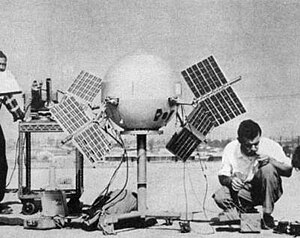Pioneer 5
| Pioneer 5 | |||||||
|---|---|---|---|---|---|---|---|
 Pioneer 5 with unfolded solar panels |
|||||||
| NSSDC ID | 1960-001A | ||||||
| Mission goal | Investigation of interplanetary space | ||||||
| Client |
|
||||||
| Launcher | Thor Able | ||||||
| construction | |||||||
| Takeoff mass | 43.2 kg | ||||||
| Course of the mission | |||||||
| Start date | March 11, 1960, 13:00 UTC | ||||||
| launch pad | CCAFS , LC-17 | ||||||
| End date | June 24, 1960 | ||||||
|
|||||||
Pioneer 5 was a space probe from the US space agency NASA . As part of the Pioneer program , it was a single mission to test new technologies and investigate interplanetary space.
construction
The original plan was to use the probe to fly by Venus . Since the start window closed before all technical difficulties were resolved, NASA decided to go on a mission to investigate interplanetary space .
Pioneer 5 was spherical in shape, 66 cm in diameter. After unfolding the solar panels, it had a span of 140 cm. She weighed 43.2 kilograms, of which 18.2 kilograms were attributable to the instruments on board. The probe had several measuring instruments on board, including a Geiger counter , a search lobe magnetometer, a micrometeorite detector and a proportional counter . Communication took place via a 5-watt or 150-watt transmitter, with the 5-watt transmitter working as a preamplifier for the 150-watt transmitter.
mission
After launch, Pioneer 5 was placed in a heliocentric orbit between Venus and Earth's orbit. On April 30th there were first problems with the data transfer. On June 26, 1960, contact with the probe was finally broken off. The last time you had contact with her was from a distance of 36.2 million kilometers. This was a record up to Mariner 2 .
Results
The mission was a success: Pioneer 5 was designed to last around a month, which it far exceeded. The new technologies, including digital data transmission for the first time, were successfully tested. In addition, the existence of an interplanetary magnetic field was confirmed. In addition, the probe was able to detect solar storm particles.
Web links and sources
- Description of the Pioneer 5 mission in the NSSDC (English)
- Description of the Pioneer 5 mission at nasa.gov/Solar System Exploration (English)
- Bernd Leitenberger: The Pioneer Program

